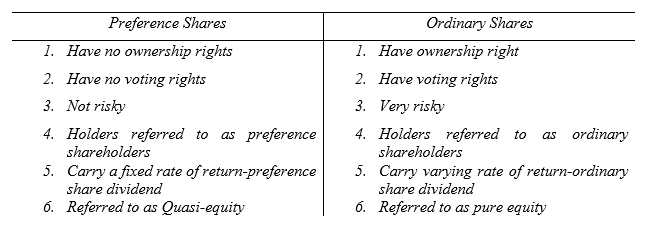Preference Shares
Preference Shares are financial instruments issued by a company to raise capital just like in the case of ordinary shares.
Where do preference shares Apply?
Preference Shares apply on matters of capital structure of an organization.
Preference Shares are required in cases where the owners of the company want to mitigate risks associated to ordinary shares.
How does Preference Shares work?
When the company management declares dividends, the Preference Shareholders are given the first priority as compared to ordinary shareholders. That’s why they are referred to as preference shares.
Difference between Preference Shares and Ordinary Shares

Notes
- Preference shares are called so (preference) because they are ranked first when dividends are being paid as compared to ordinary shares and also ranked first when the claims are being paid if the company is terminated or under bankruptcy.
- Ordinary shareholders have a voting right unlike preference shareholders because ordinary shareholders has ordinary shares which carry ownership rights.
- Ordinary shares are very risky as compared to preference shares because the returns (dividends) declared at the end of every financial period keep on varying (ie risky) unlike the preference shares which have a pre-determined returns and hence cannot be changed. The preference shareholders are rest assured of receiving their dividends even if the company does not make profits. This risky aspect motivates the ordinary shareholders to go ahead and cushion themselves by buying preference shares.
-
Preference shares are said to be quasi-equity because they are usually owned by the owners of the company (i.e ordinary shareholders-equity) in addition to the ordinary shares that they have and also they carry a fixed rate of return like external debts do. So they carry both the characteristics of equity and debt-hybrid
 About the Author - Dr Geoffrey Mbuva(PhD-Finance) is a lecturer of Finance and Accountancy at Kenyatta University, Kenya. He is an enthusiast of teaching and making accounting & research tutorials for his readers.
About the Author - Dr Geoffrey Mbuva(PhD-Finance) is a lecturer of Finance and Accountancy at Kenyatta University, Kenya. He is an enthusiast of teaching and making accounting & research tutorials for his readers.